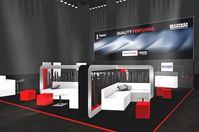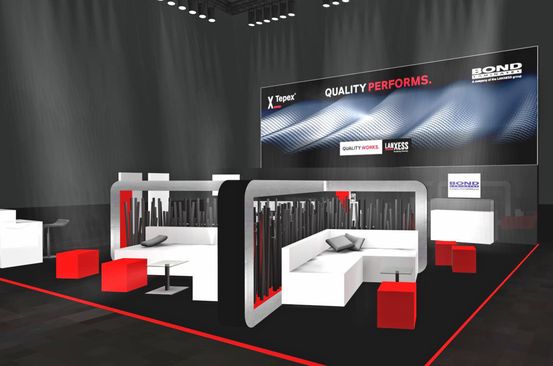Asia
EMEA

LANXESS Canada Contacts
Contact our Sites in Canada
Media Inquiries
General Inquiries
Please click here to e-mail LANXESS Canada with product inquiries and general requests.
Global Press Releases
2019-02-28
Bond-Laminates at JEC World, March 12–14, 2019, Paris-Nord Villepinte Exhibition Center, hall 5, stand N33
New applications in mass production with Tepex
- Lightweight design with excellent surface finish
- Capacity expansion in Brilon on schedule
- Recycled material types under development
Cologne – Tepex continuous-fiber-reinforced thermoplastic composites are among the few composite materials of their type worldwide to be gaining a foothold in the mass production of lightweight components. That is why Bond-Laminates GmbH, the manufacturer of Tepex and a subsidiary of specialty chemicals company LANXESS, will be putting Tepex’s new large-scale production applications right at the center of its activities at the 2019 JEC World Composites Show & Conference in Paris. “The success of Tepex is built on our diversified product range, one that features distinct differentiation by application. At the same time, the number of technologies allowing cost-effective processing of complex, highly integrated lightweight components with high-quality surfaces is growing all the time,” explains Dr. Dirk Bonefeld, who is responsible for areas including sales in the Consumer Electronics and Sport application segments at Bond-Laminates.
Owing to high demand for Tepex – primarily from the automotive and IT industries – LANXESS is currently carrying out a major expansion of its production facilities for the structural material in Brilon, Germany. As Bonefeld comments, “We are on schedule to have two additional production lines up and running by mid-2019.”
New applications in light weight design and electric mobility
The new applications for Tepex in lightweight automotive design include door module carriers for a German mid-size vehicle, front end carriers of SUVs (sport utility vehicles) for the US market and rear seats for a German luxury car. “Series production applications such as carriers for electrical and electronics modules and components of lithium-ion battery modules are emerging in the field of electric mobility,” states Henrik Plaggenborg, head of Tepex Automotive, looking to the future of the sector.
On a par with new goods
One example of materials currently under development comes in the form of Tepex product types made from recycled fibers in a matrix of recycled thermoplastic material. “Tests on initial material samples have already demonstrated that these types of recycled material are on a par in terms of mechanical and flame-retardant properties with their equivalents made from new materials,” explains Bonefeld.
In-mold decoration
One example of a new processing technology opening up new areas of application for Tepex is a hybrid manufacturing process. It combines hybrid molding with in-mold decoration (IMD) technology. “The painting of components made using hybrid molding can be integrated into the injection molding tool. This simplifies the entire process, and saves having to use a painting line,” comments Bonefeld. Alongside its partners, Bond-Laminates had already showcased a variation of the method ready for large-scale production at the K trade show back in 2016.
Directly paintable laptop lids
Typical applications for Tepex in the IT industry include the lids of laptops, tablets and smartphones. These tend to be made using the hybrid molding method. This involves the semi-finished composite product being formed in an injection molding tool and then being given additional features such as reinforcing ribs, guide channels and snap fits by means of injection molding. “Not having to use a forming tool, the high level of automation and the short cycle times coupled with limited waste result in a production process that, despite higher costs for the injection molding tool, is much more cost-effective than the separate forming and back injection molding methods previously used for the semi-finished product, or other processes based on thermoset plastics or even light metals,” explains Bonefeld. Not only that, but the method also produces smooth, directly paintable surfaces and eliminates the need to apply a filler layer that levels out small rough spots such as sink marks and microholes.
Forward-Looking Statements
This company release contains certain forward-looking statements, including assumptions, opinions, expectations and views of the company or cited from third party sources. Various known and unknown risks, uncertainties and other factors could cause the actual results, financial position, development or performance of LANXESS AG to differ materially from the estimations expressed or implied herein. LANXESS AG does not guarantee that the assumptions underlying such forward-looking statements are free from errors nor does it accept any responsibility for the future accuracy of the opinions expressed in this presentation or the actual occurrence of the forecast developments. No representation or warranty (expressed or implied) is made as to, and no reliance should be placed on, any information, estimates, targets and opinions, contained herein, and no liability whatsoever is accepted as to any errors, omissions or misstatements contained herein, and accordingly, no representative of LANXESS AG or any of its affiliated companies or any of such person's officers, directors or employees accept any liability whatsoever arising directly or indirectly from the use of this document.
LANXESS is a leading specialty chemicals company with sales of EUR 9.7 billion in 2017. The company currently has about 15,500 employees in 33 countries and is represented at 59 production sites worldwide. The core business of LANXESS is the development, manufacturing and marketing of chemical intermediates, additives, specialty chemicals and plastics. LANXESS is listed in the leading sustainability indices Dow Jones Sustainability Index (DJSI World and Europe) and FTSE4Good.
- Gallery




